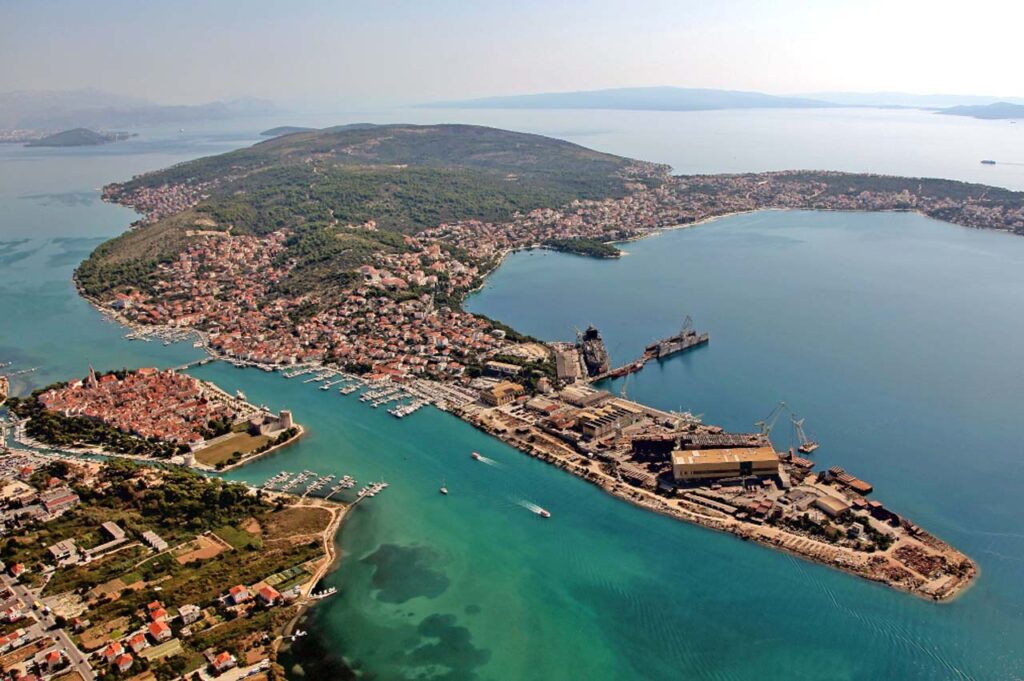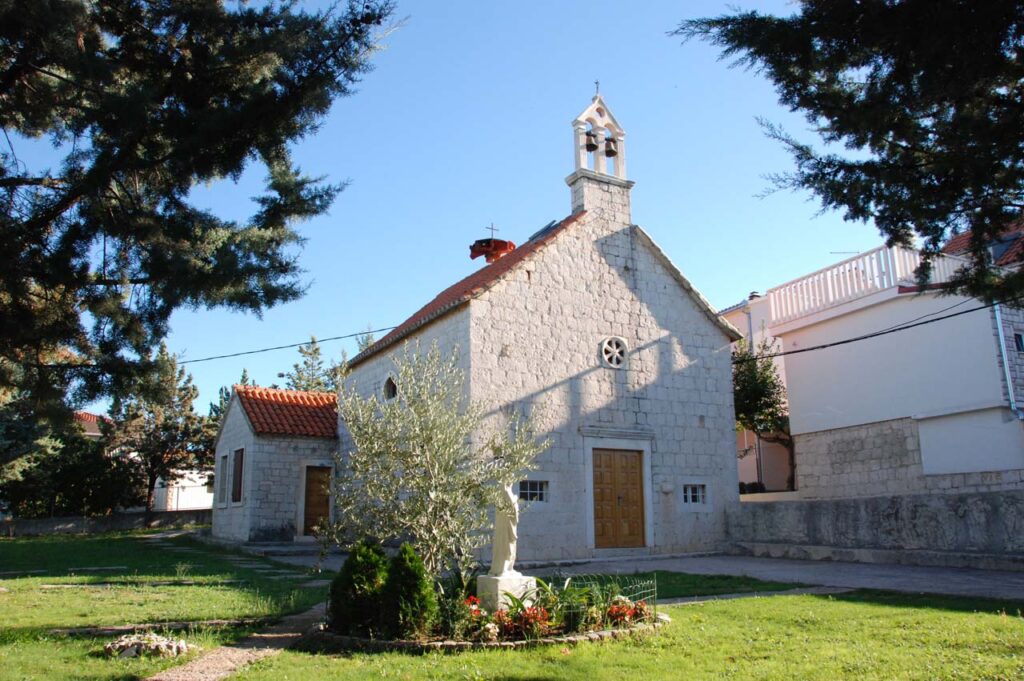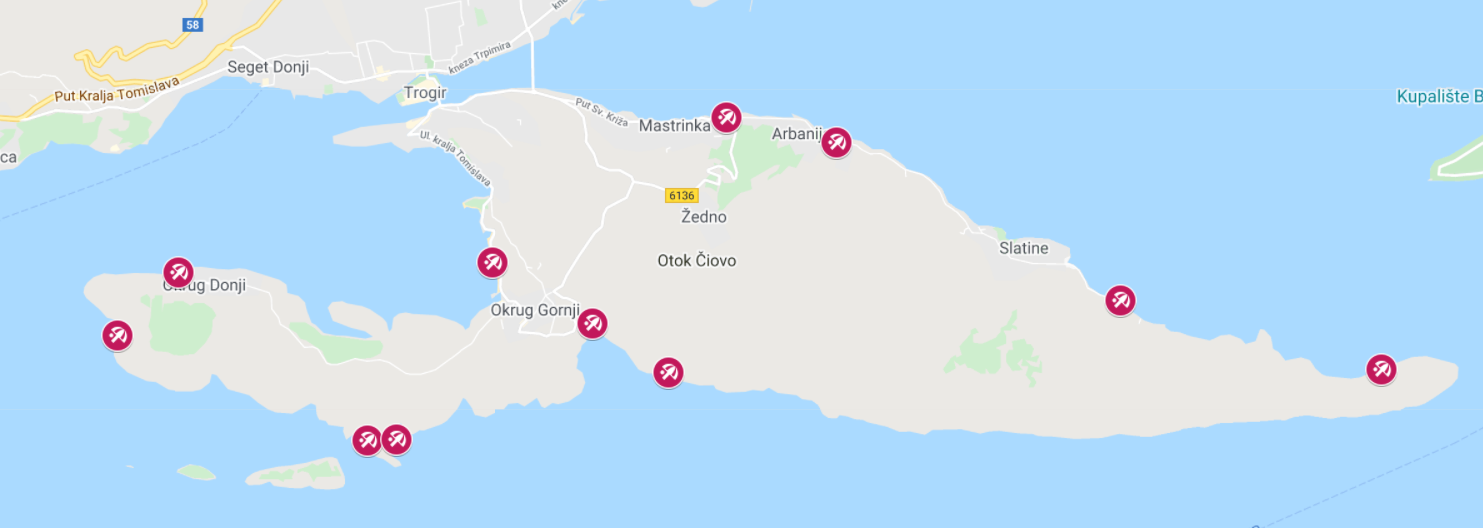GENERAL INFO
Čiovo is a small island located off the Adriatic coast in Croatia with an area of 28.8 square kilometers (11.1 sq mi) (length 15.3 km (9.5 mi), width up to 3.5 km (2.2 mi)). In the Middle Ages, Čiovo had many villages and it was a place for lepers. Remains of the pre-Romanesque church of St. Peter have been found near Slatine, in the Supetar cove. The medieval church of St. Maurice (Sv. Mavro) has been preserved in Žedno and the pre-Romanesque church of Our Lady near the Sea (Gospa pokraj mora). The population of Čiovo increased in the 15th century through the settlement of refugees who fled from the Turks. Simultaneously, the suburban areas of Trogir also extended to Čiovo.

Nowadays it consists of many villages. On the east side, from Trogir crossing the bridge and then left, there is the village Mastrinka, then Arbanija and Slatine at the end. Over the hill there is the small settlement of Žedno. Again from Trogir crossing the bridge and then right, there is Okrug Gornji and the Okrug Donji, at the very end of the island. On the southern side of the island then there are Mavaštica (south-east), Bušinci and Rastići (south-west). All this villages are full of apartments and villas, making of the island of Čiovo a big holiday resort which attracts many tourists all over the world.

CULTURAL HERITAGE
Many are the churches which can be seen on the island of Čiovo.
Close to Trogir on the small hill Bilin Dolac, it is settled the Franciscan monastery of St. Anthony and the Church of St. Jerome which has preserved its appearance from the XVII. century. The convent guards the crown made of silver with jewels from XIV. century. The monastery keeps a painting by Palma the Younger and a sculpture of St. Magdalene by Ivan Duknović.
Continuing on the west side of the island in the small village Arbanija at only 5 kilometres (3 miles) from Trogir you will find the church
and the Dominican monastery of the Holy Cross (Sv. Križ), built in the 15th century by the masters Ivan Drakanović and Nikola Mladinov. The monastery features a nice cloister; the polychrome vault of the dining room has been preserved, as well as the paintings by Matija Poncun and other.
Along the cost, in the centre of Slatine it stands the Church of the Assumption of the Blessed Virgin Mary from the XVII century. Following the eastern coast, up the cliff is the nicely located hermitage church of Our Lady of Prizidnica. The church in Prizidnice was built in 1546 by priest J. Strojdražić, the hermit of Prizidnice who had settled there years before. It is 460 years old and many stories and legends are connected with the place itself, which elder people from Slatine will gladly share when you visit it.
Going back and over the hill which starts at the church of the Holy Cross (Sv. Križ), in the small village Žedno, two other small churches will be found. The first one is in the centre of the village, the Church of the Blessed John from Trogir and the church of St. Mauro from the 4th century. The church gives its name to the small settlement “Movarčica”, the today Mavarštica.
Following the route to Okrug Gornji, passing through a narrow passage, on your left side it stands the Parish Church of St. Charles Borromeo, built in its present form in 1735. Previously, in its place there was a chapel dedicated to the same saint. Today the church is a simple rectangular building with an apse and distaff with two bells on the front side.
Along the south-western side of Čiovo, vis-a-vis the beach, is a small island called Fumija, with the remains of the late antique or early medieval church of St. Fumija and farm buildings of the Benedictine monks from Trogir. Following the road in direction of Okrug Donji, it is erected the Chapel of St. John the Baptist. Unknown is the year of construction. The poet Andreis mentions it in the 17th century saying it was built by villagers.
On the other side, two bays, today very visited by the sailors, the Kancelirovac bay on the northwest coast of the island of Ciovo with remains of Citadel of Saint John, raised like a fortress on the rock cliffs and the bay of Racetinovac, with the rest of mansion of the family Racettin. This pious family builds the mansion and a church dedicated to St. Anthony in the year 1630.
Coming back to Trogir, long the sea side, not so far from Trogir and it the middle of the so called Copacabana beach, it stands the small Church of St. Theodore, located near the sea. The year of construction of the church is not known, but it is referred to 1439. The present church was built on the site of the demolished old Croatian church. The church was declared a cultural monument in 1963. The local cemetery is just next to the church.



MOST POPULAR BEACHES ON ČIOVO ISLAND
Čiovo is a small island located off the Adriatic coast in Croatia with an area of 28.8 square kilometers (11.1 sq mi) (length 15.3 km (9.5 mi), width up to 3.5 km (2.2 mi)). It consists of many villages. On the east side, from Trogir crossing the bridge and then left, there is the village Mastrinka, then Arbanija and Slatine at the end. Over the hill there is the small settlement of Žedno. Again from Trogir crossing the bridge and then right, there is Okrug Gornji and the Okrug Donji, at the very end of the island. On the southern side of the island then there are Mavarstica (south-east), Businci and Rastici (south-west). All this villages are full of apartments and villas, making of the island of Ciovo a big holiday resort which attracts many tourists all over the world.
CLICK ON THE PICTURE TO SEE THE MAP
DISCOVER ČIOVO BY BIKE
The island of Čiovo is connected with Trogir by a bridge and administratively divided between Split, Trogir and Okrug. Known for its Mediterranean climate, rich vegetation and the archipelago of small picturesque islands, Čiovo turns a relaxing holiday in search of hidden secrets of the rich cultural and historical heritage from the early to ancient times. Small sandy beaches, steep cliffs, blossoming agaves and many species of indigenous plants, are only part of the mosaic of the island to be explored. In which way? Biking. Five tracks tailored for beginners and ambitious amateurs will not leave anyone indifferent, and this experience will certainly remain for long in your memory. We have designed 5 different biking routes for everybody taste (click on the map and discover them). Take a look and discover the island of Čiovo.


